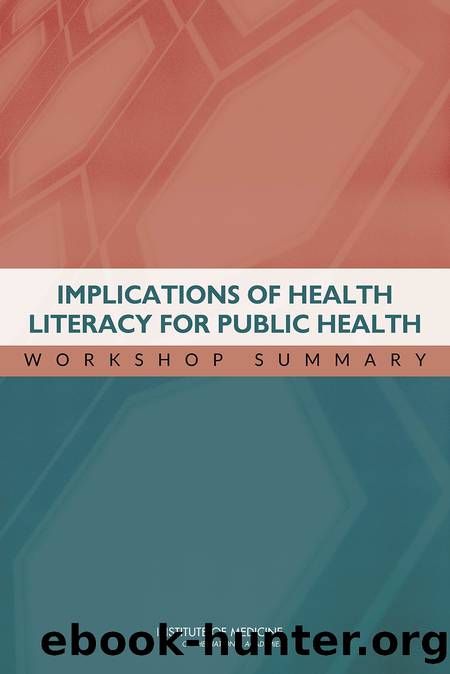Implications of Health Literacy for Public Health: Workshop Summary by Maria Hewitt

Author:Maria Hewitt
Language: eng
Format: epub
Tags: ebook, book
Publisher: The National Academies Press
Published: 2014-09-17T00:00:00+00:00
Bishop highlighted the need to consider health literacy as a part of health equity and mentioned that health literacy could be integrated into an upcoming Health Equity Report to the state legislature.
ACADEMIA: PROFESSIONAL TRAINING AND CERTIFICATION
Olivia Carter-Pokras, Ph.D.
University of Maryland School of Public Health
Carter-Pokras said she has worked in public health education and training for three decades, the past 10 years of which have been spent in academia, including 6.5 years in an accredited school of public health. She currently serves on the Education Board for the American Public Health Association (APHA).
The Council on Education for Public Health (CEPH) is the accrediting body for public health schools and programs. The Council has accredited 51 schools and 102 programs, and is reviewing 30 applications for accreditation. According to the Councilâs most recent data, more than 10,000 public health students graduated in 2009. Enrollment in nonaccredited public health programs exceeded that of accredited programs. Among graduates of accredited programs, 6,700 earned a masterâs of public health (M.P.H.) degree. Twenty schools and 8 programs have undergraduate programs in public health. Carter-Pokras added that public health is one of the fastest growing majors in the country. In fall 2013, CEPH finalized procedures for accreditation for new undergraduate programs.
The Association of Schools and Programs of Public Health has developed a core competency model that includes a section on health literacy. Under its competency related to diversity and culture, the Association states that a graduate of an M.P.H. program should be able to explain why cultural competence alone cannot address health disparity. Graduates should also be able to differentiate among the terms âlinguistic competence,â âcultural competency,â and âhealth literacyâ in the context of public health practice. The Associationâs study guide for students planning to take the examination for certification in public health does not include the definition of health literacy. The study guide does, however, include the definitions of linguistic competence, cultural competence, and cultural and linguistic competence. In Carter-Pokrasâ view, this represents a shortcoming and something that could be corrected.
Carter-Pokras, as a graduate of the Bloomberg School of Public Health at Johns Hopkins University, investigated how health literacy was addressed at the school. Carter-Pokras found that within the M.P.H. competencies, there is a section called social and behavioral competencies. There is no specific mention of health literacy, but communication issues are addressed. According to the competencies, graduates with an M.P.H. from Johns Hopkins should be able to âformulate communication strategies for improving the health of communities and individuals and preventing disease and injury.â
According to Carter-Pokrasâ discussions with teaching staff at Johns Hopkins, health literacy is discussed briefly in two of the required coursesâTools of Public Health Practice and Decision Making, and Problem Solving in Public Health. Neither of the courses has assigned readings on health literacy. Instead, the topic is embedded in discussions related to communication. An elective health literacy course is offered.
Carter-Pokras said that the absence of a focus on health literacy at Johns Hopkins is likely not unique and that similar findings would probably be observed in schools across the country.
Download
This site does not store any files on its server. We only index and link to content provided by other sites. Please contact the content providers to delete copyright contents if any and email us, we'll remove relevant links or contents immediately.
Application of a Novel Technique for Clinical Evaluation of Nitric Oxide-Induced Free Radical Reactions in ICU Patients by Unknown(696)
Rosenâs Emergency Medicine Concepts and Clinical Practice by Ron Walls; Robert Hockberger; Marianne Gausche-Hill; Timothy B. Erickson; Susan R. Wilcox(572)
Oxidative damage to surfactant protein D in pulmonary diseases by Vitality Starosta1 & Matthias Griese1†(408)
Social Science Perspectives on Global Public Health by Vincent La Placa & Julia Morgan(373)
Constructing Canine Consent; Conceptualising and Adopting a Consent-focused Relationship with Dogs by ERIN JONES(330)
Organic Chemistry: An Acid - Base Approach by MICHAEL SMITH(299)
ADVANCED EMERGENCY CARE AND TRANSPORTATION OF THE SICK AND INJURED by Unknown(271)
Saunders Nursing Drug Handbook 2024 - E-Book by Unknown(263)
Socio-Life Science and the COVID-19 Outbreak : Public Health and Public Policy by Makoto Yano; Fumihiko Matsuda; Anavaj Sakuntabhai; Shigeru Hirota(246)
Diagnostic and Statistical Manual of Mental Disorders, Fifth Edition, Text Revision (DSM-5-TR(tm)) by Unknown(246)
Davis's Comprehensive Manual of Laboratory and Diagnostic Tests with Nursing Implications by Unknown(245)
Human Microanatomy; Cell Tissue and Organ Histology with Celebrity Medical Histories by Stephen A. Stricker(243)
Berne and Levy Physiology E-Book by Unknown(234)
Replacing the Dead by Mie Nakachi;(229)
Handbook of Skin Disease Management by Jiyad Zainab;Flohr Carsten; & Carsten Flohr(228)
Access to Medicines and Vaccines in the South : Coherence of Rules and Policies Applied by the European Union Commission by Stephen Kingah(225)
The Pocket Guide to Sensorimotor Psychotherapy in Context (Norton Series on Interpersonal Neurobiology) by Pat Ogden(218)
Deep Learning and Medical Applications by Unknown(217)
Advances and Technical Standards in Neurosurgery by Unknown(214)
